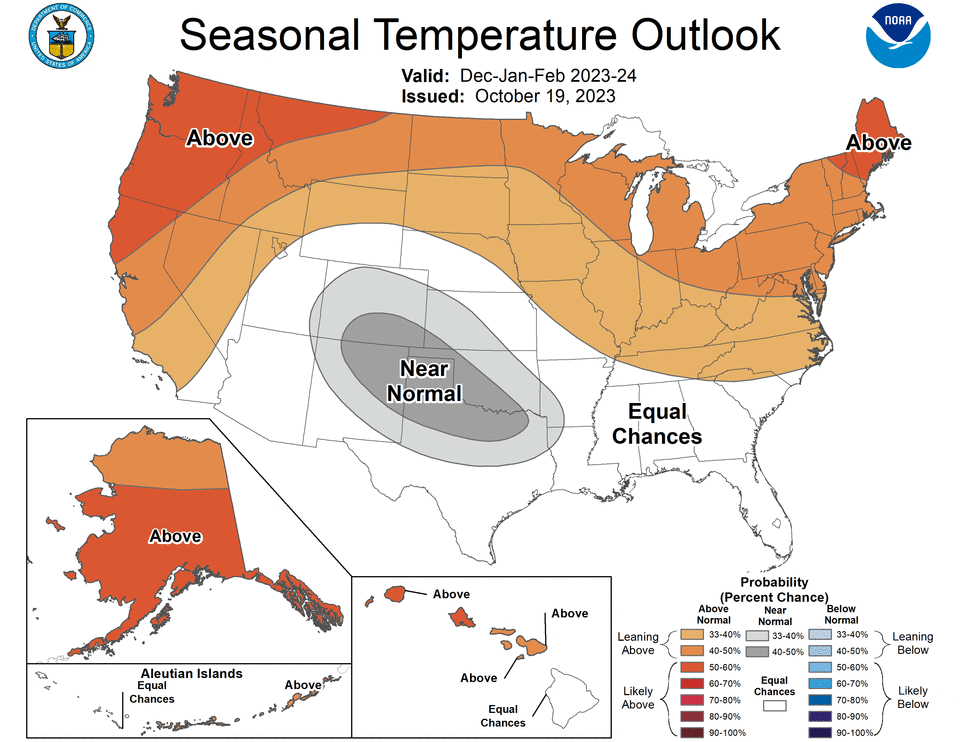El Niño and climate change battle it out. How will this impact winter in Georgia?

Experts say a pair of environmental phenomena − climate change and El Niño − are seemingly competing to determine if the Georgia gets a mild or severe winter season.
“It’s difficult to say that climate change is the only cause of warm temperatures in the fall and winter,” said Nyasha Dunkley, the deputy state climatologist in Georgia. “There are so many factors that are at play; factors that are competing with one another. Whichever one wins out determines what your fall or winter is going to look like.”
In looking back at September through December 2021 as a comparison to this year, it was the 11th warmest period on record, said Dunkley.
“In December (2021) we had the second warmest temperature of record,” said Dunkley. “I also looked at 2022 and we were slightly above normal temperatures. And so far this year, September and October, we've been above normal.”
El Niño at play in winter weather forecasts
The National Oceanic and Atmospheric Administration issues a winter outlook for December through February and noted that El Niño is in play for the first time in four years.
NOAA predicts wetter-than-average conditions for northern Alaska, portions of the West, the southern Plains, Southeast, Gulf Coast and lower mid-Atlantic and drier-than-average conditions across the northern tier of the U.S., especially in the northern Rockies and High Plains and near the Great Lakes.
“When we create outlooks we take a look at what the active climate drivers are,” said Johnna Infanti, meteorologist at the operational prediction branch of the NOAA Climate Prediction Center. “A climate driver would be something like El Niño or La Niña and anything else that’s happening around the globe that could be impacting the climate of North America. We also look at decadal trends ... how the climate has been changing over North America for the past 10 years or so.”

Using climate history to predict weather
For instance, has a region been getting warmer or cooler, drier or wetter. Infanti said these weather histories are determining factors when making outlooks.
“In the case of the Southeast region, El Niño is a very big driver of a lot of your climate signals when it’s active,” said Infanti. “If you take a look at the outlook for the Southeast region, there's a dark area of green precipitation and that's a lot to do with El Niño.”
Infanti said with El Niño and precipitation, El Niño events result in a strong and persistent extended jet stream from northern Mexico east along the Gulf Coast.
“This results in a southward shift of the storm track from the northern part of the U.S to the southern part,” she said. “On El Niño ... maximum temperatures and average temperatures tend to be below normal. This tendency can be offset by long term warming trends.”
Aside from history, a number of tools are used to create the seasonal outlooks, said Infanti.
“We use suite dynamical climate models from forecasting centers around the U.S. and internationally,” she said. “We also use statistical models, expected impacts or “teleconnections” from climate states such as the El Niño Southern Oscillation (ENSO), decadal trends, land surface states like soil moisture and snow cover (when appropriate), local sea surface temperature anomalies, and the state of sea ice.”
Future of farming: As climate change impacts the future of farming, experts seek ways to adapt
Even with better tools, weather can be tough to predict
With the array of scientific tools to predict the winter outlook, there’s still some level of uncertainty, said Infanti.
“If you take a look at the outlook right over Augusta, Georgia it’s mostly white,” said Infanti. “That means that we actually have some uncertainty about your region. White means that there's equal chances for above, near and below normal temperatures. Typically, this means that we've got conflicting signals in our tools and we had some uncertainty there.”
Thomas Mote, professor of geography and atmospheric science at the University of Georgia, said when examining the changes, the time period and season have to be considered.
“Over that 120-plus year period, we've seen most of our warming in autumn and winter,” said Mote. “Now, if you look more recently, in the past several decades, we've seen warming across all seasons.”
Mote said El Niño could impact certain crops.
“I’ve done some research on the impacts of El Niño in Georgia in the past,” said Mote. “Peaches need a certain number of chilling hours every winter to produce. When we look at the impact of El Niño, you would think okay, well, it's gonna be cooler than normal. That might help with the chilling hours.
“The reason that it tends to be cooler than normal is associated with depressed daytime high temperatures associated with increased cloud cover and rainfall during El Niño and not necessarily cooler nights. Therefore, while El Niño may give us a cooler winter than we would otherwise expect, it might not necessarily help with the chilling hours one might need for a peach crop, for example.”
This reporting content is supported by a partnership with several funders and Journalism Funding Funding Partners.
Erica Van Buren is the climate change reporter for The Augusta Chronicle, part of the USA TODAY Network. Connect with her at EVanBuren@gannett.com or on Twitter: @EricaVanBuren32.
This article originally appeared on Augusta Chronicle: Climate change and El Niño offer uncertainty for winter forecast

